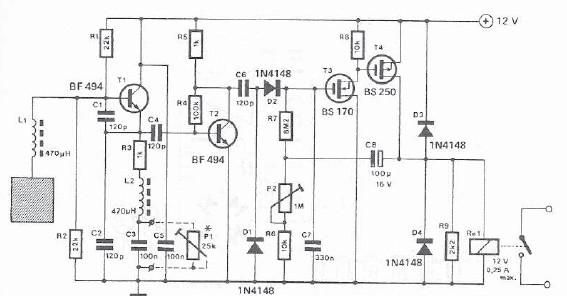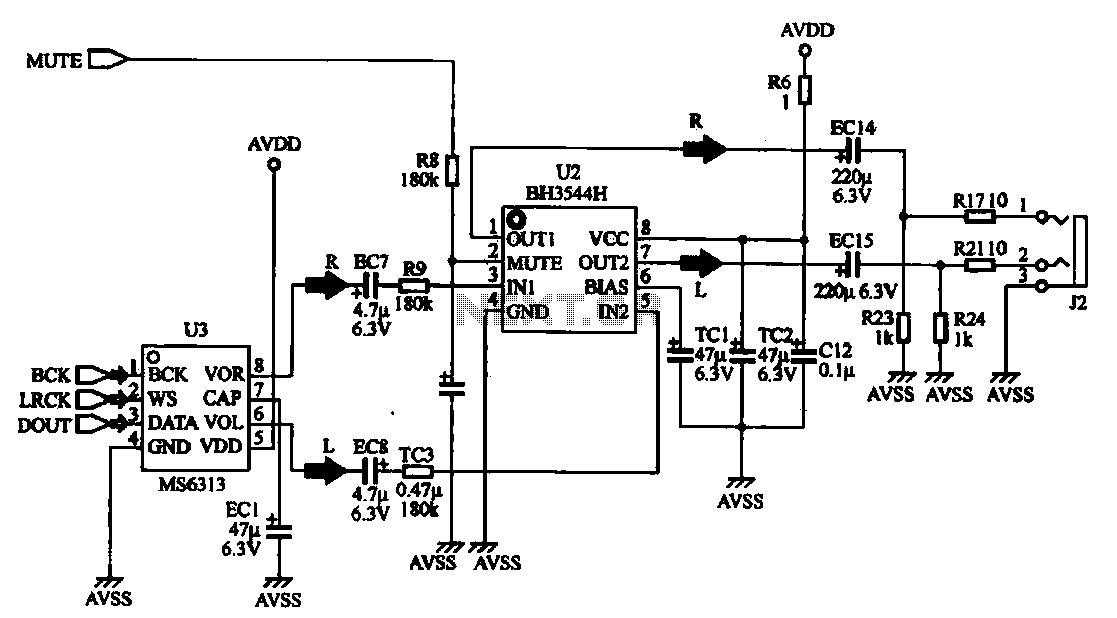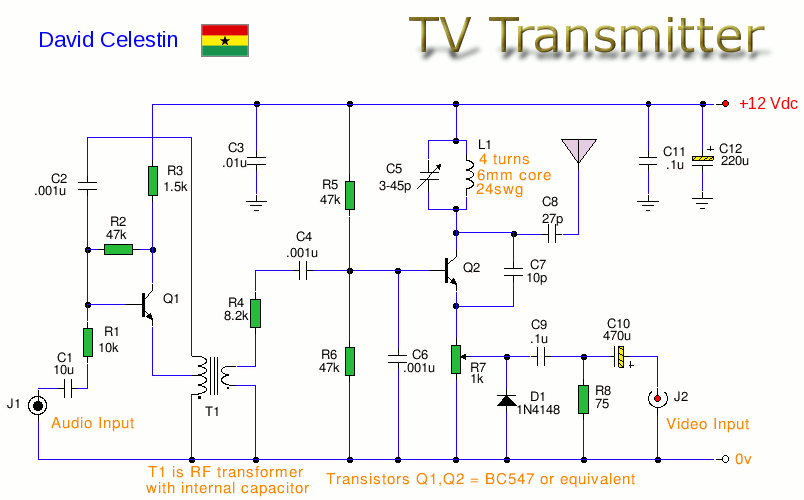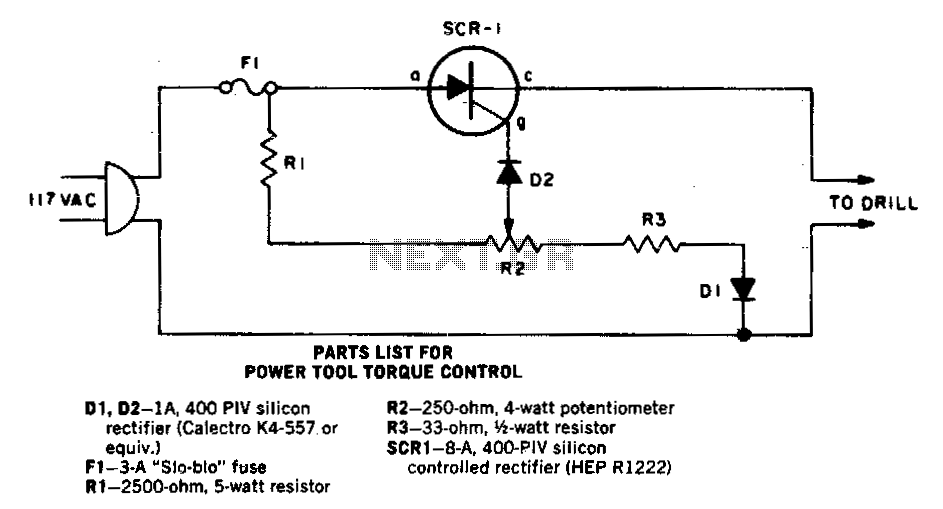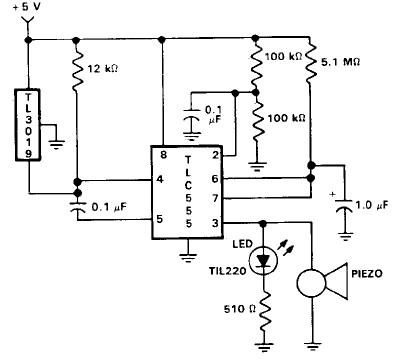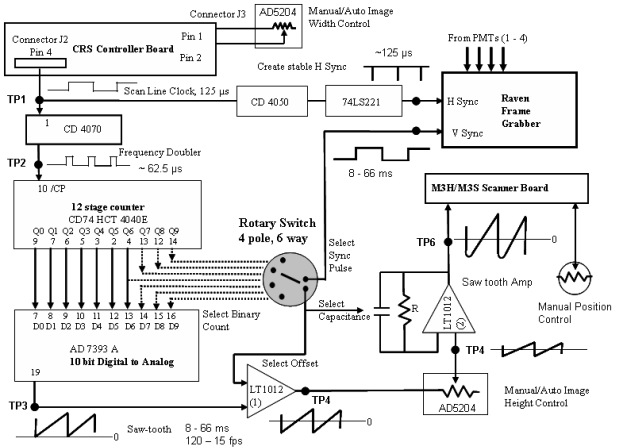
temp control circuit
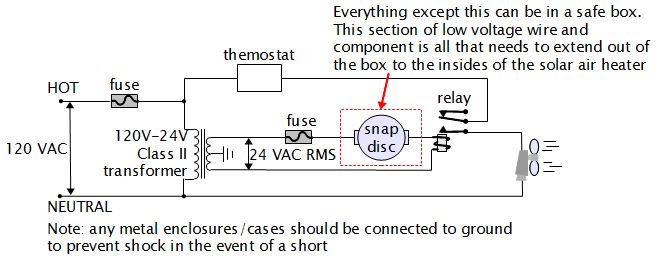
For various experiments, such as solar air heaters, an automatic fan activation and deactivation system is required. A straightforward solution is to use a bimetal snap disc thermal sensor. This sensor functions as a switch that closes when a specific high temperature is reached and opens when a specific lower temperature is attained. By connecting a fan in series with the switch, the fan will activate when the high temperature threshold is met and deactivate once the lower temperature is reached. These devices are also known as snap disk controllers or snap switches. In the UK, they are commonly referred to as thermostats or bimetallic thermostats and can be sourced from suppliers such as Sinolec Components or RS Components. It is essential to select a sensor with an activation temperature higher than the deactivation temperature; typical values are 110°F for activation and 90°F for deactivation. Caution is advised when using wire types; while Romex wire may be shown in various demonstrations, it is recommended to use Teflon insulated wire for connections extending into the solar air heater. This is crucial because, on sunny days, temperatures within the heater can exceed 200°F (93°C), potentially surpassing the insulation rating of standard wires, which could lead to short circuits and fire hazards. Instructional videos provide step-by-step guidance for constructing the AC circuit, including an introduction to the snap disc sensor, testing a prototype, and determining the appropriate fuse size for the fan or blower. Safety is emphasized in the subsequent video, which demonstrates the correct assembly of the circuit within a protective enclosure and its installation in the solar air heater. To prevent the solar air heater from producing excessive heat when the room is already warm, a thermostat can be integrated into the circuit. This device acts as an additional switch, opening when the room reaches a sufficient temperature and closing when more heat is needed. The accompanying diagram illustrates the setup with the thermostat included. In this configuration, the snap disc sensor is located within the solar air heater, exposed to 120VAC. For safety and efficiency, it may be preferable to implement lower voltage wiring, which can be accommodated by an alternative schematic. This allows for the majority of the circuitry to be housed in a box mounted to the blower or fan enclosure, enabling the use of higher 120VAC wiring, while only lower voltage 24VAC wires extend to the snap disc sensor's location.
The bimetal snap disc thermal sensor operates based on the principle of thermal expansion. It consists of two different metals bonded together, which expand at different rates as temperature increases. When the temperature exceeds the setpoint, the bimetal disc bends, causing it to close the circuit and activate the fan. Conversely, when the temperature drops below the lower setpoint, the disc returns to its original shape, opening the circuit and turning off the fan. The selection of the activation and deactivation temperatures can be adjusted based on the specific application requirements, providing flexibility in managing the heating process.
In the context of solar air heaters, the proper placement of the snap disc sensor is critical for accurate temperature readings. It should be positioned in an area where it can effectively monitor the air temperature being heated by the solar collector. The fan used in conjunction with the sensor should be rated for the appropriate voltage and current, ensuring it can handle the operational demands without overheating.
For installations requiring lower voltage operations, a transformer can be utilized to step down the voltage from the mains supply to the desired level, ensuring safety and compliance with electrical standards. The transformer should be rated according to the load requirements of the fan and any additional components in the circuit.
In summary, the integration of a bimetal snap disc thermal sensor with a fan in a solar air heater application provides an efficient and automated solution for temperature control. Proper component selection, wiring, and installation practices are essential for ensuring safety, reliability, and optimal performance of the system.For a few experiments such as solar air heaters, I needed a automatic turning on and off of a fan. Probably the simplest way to do this is with a bimetal snap disc thermal sensor. A bimetal snap disc thermal sensor is basically a switch that closes when a specific high temperature is reached and opens when a specific lower temperature is reached. That way, by connecting in a fan in series with the switch, the fan would turn on when the high temperature is reached and off then the lower temperature is reached. They are also referred to as snap disk controllers and snap switches. In the UK they`re often referred to as thermostats or bimetalic thermostats and can be found at Sinolec Components - or RS Components - uk.
rs-online. com. Make sure you get one where the temperature that turns on the fan (the switch closes) is higher than the temperature that turns off the fan (the switch opens. ) Most people use ones that turn on at 110F and off at 90F. WARNING: Many of the following photos and videos show Romex wire being used for the length of wire extending into the solar air heater to the snap disc sensor.
These were used in experimental situations. Consider using teflon insulated wire instead. Why If it`s a sunny day and no air is being circulated through the heater because the house is already hot enough then the temperature where the wire is inside the solar air heater may get over 200F (93C). This may be over the wire`s insulation`s rating. If the insulation melts it may cause a short circuit and result in a fire. The following videos give step-by-step details for making the AC circuit. The first video introduces the snap disc sensor, tests a prototype circuit and shows how to determine the size of fuse needed for your fan or blower.
It`s especially useful for anyone not familiar with electronics. This next video wires up the actual circuit in a safe manner (safety is imporant here since it`s being plugged into the household wiring), assembles it all in a nice box, puts it in the actual solar air heater and does a quick test. If your room is already hot enough then you don`t want your solar air heater to provide more hot air.
This can be controlled by adding a thermostat to the circuit. The thermostat is basically another switch that opens when the room is hot enough and closes when the room needs more heat. The following diagram has the themostat added. The snap disc sensor is located in the solar air heater. Using the above schematic, the sensor has 120VAC across it. It may be preferable to have lower voltage wiring in this area and for that the following schematic can be used.
All other circuitry can be housed in a box that is mounted to the blower/fan enclosure and so all wiring there can have the higher 120 volts AC while only lower voltage 24 volts AC wires would extend out to the location of the snap disc sensor. 🔗 External reference
The bimetal snap disc thermal sensor operates based on the principle of thermal expansion. It consists of two different metals bonded together, which expand at different rates as temperature increases. When the temperature exceeds the setpoint, the bimetal disc bends, causing it to close the circuit and activate the fan. Conversely, when the temperature drops below the lower setpoint, the disc returns to its original shape, opening the circuit and turning off the fan. The selection of the activation and deactivation temperatures can be adjusted based on the specific application requirements, providing flexibility in managing the heating process.
In the context of solar air heaters, the proper placement of the snap disc sensor is critical for accurate temperature readings. It should be positioned in an area where it can effectively monitor the air temperature being heated by the solar collector. The fan used in conjunction with the sensor should be rated for the appropriate voltage and current, ensuring it can handle the operational demands without overheating.
For installations requiring lower voltage operations, a transformer can be utilized to step down the voltage from the mains supply to the desired level, ensuring safety and compliance with electrical standards. The transformer should be rated according to the load requirements of the fan and any additional components in the circuit.
In summary, the integration of a bimetal snap disc thermal sensor with a fan in a solar air heater application provides an efficient and automated solution for temperature control. Proper component selection, wiring, and installation practices are essential for ensuring safety, reliability, and optimal performance of the system.For a few experiments such as solar air heaters, I needed a automatic turning on and off of a fan. Probably the simplest way to do this is with a bimetal snap disc thermal sensor. A bimetal snap disc thermal sensor is basically a switch that closes when a specific high temperature is reached and opens when a specific lower temperature is reached. That way, by connecting in a fan in series with the switch, the fan would turn on when the high temperature is reached and off then the lower temperature is reached. They are also referred to as snap disk controllers and snap switches. In the UK they`re often referred to as thermostats or bimetalic thermostats and can be found at Sinolec Components - or RS Components - uk.
rs-online. com. Make sure you get one where the temperature that turns on the fan (the switch closes) is higher than the temperature that turns off the fan (the switch opens. ) Most people use ones that turn on at 110F and off at 90F. WARNING: Many of the following photos and videos show Romex wire being used for the length of wire extending into the solar air heater to the snap disc sensor.
These were used in experimental situations. Consider using teflon insulated wire instead. Why If it`s a sunny day and no air is being circulated through the heater because the house is already hot enough then the temperature where the wire is inside the solar air heater may get over 200F (93C). This may be over the wire`s insulation`s rating. If the insulation melts it may cause a short circuit and result in a fire. The following videos give step-by-step details for making the AC circuit. The first video introduces the snap disc sensor, tests a prototype circuit and shows how to determine the size of fuse needed for your fan or blower.
It`s especially useful for anyone not familiar with electronics. This next video wires up the actual circuit in a safe manner (safety is imporant here since it`s being plugged into the household wiring), assembles it all in a nice box, puts it in the actual solar air heater and does a quick test. If your room is already hot enough then you don`t want your solar air heater to provide more hot air.
This can be controlled by adding a thermostat to the circuit. The thermostat is basically another switch that opens when the room is hot enough and closes when the room needs more heat. The following diagram has the themostat added. The snap disc sensor is located in the solar air heater. Using the above schematic, the sensor has 120VAC across it. It may be preferable to have lower voltage wiring in this area and for that the following schematic can be used.
All other circuitry can be housed in a box that is mounted to the blower/fan enclosure and so all wiring there can have the higher 120 volts AC while only lower voltage 24 volts AC wires would extend out to the location of the snap disc sensor. 🔗 External reference
